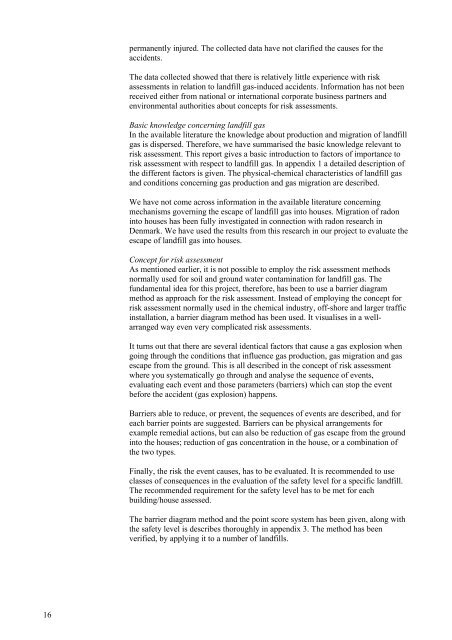Metode til risikovurdering af gasproducerende ... - Miljøstyrelsen
Metode til risikovurdering af gasproducerende ... - Miljøstyrelsen
Metode til risikovurdering af gasproducerende ... - Miljøstyrelsen
Create successful ePaper yourself
Turn your PDF publications into a flip-book with our unique Google optimized e-Paper software.
permanently injured. The collected data have not clarified the causes for theaccidents.The data collected showed that there is relatively little experience with riskassessments in relation to landfill gas-induced accidents. Information has not beenreceived either from national or international corporate business partners andenvironmental authorities about concepts for risk assessments.Basic knowledge concerning landfill gasIn the available literature the knowledge about production and migration of landfillgas is dispersed. Therefore, we have summarised the basic knowledge relevant torisk assessment. This report gives a basic introduction to factors of importance torisk assessment with respect to landfill gas. In appendix 1 a detailed description ofthe different factors is given. The physical-chemical characteristics of landfill gasand conditions concerning gas production and gas migration are described.We have not come across information in the available literature concerningmechanisms governing the escape of landfill gas into houses. Migration of radoninto houses has been fully investigated in connection with radon research inDenmark. We have used the results from this research in our project to evaluate theescape of landfill gas into houses.Concept for risk assessmentAs mentioned earlier, it is not possible to employ the risk assessment methodsnormally used for soil and ground water contamination for landfill gas. Thefundamental idea for this project, therefore, has been to use a barrier diagrammethod as approach for the risk assessment. Instead of employing the concept forrisk assessment normally used in the chemical industry, off-shore and larger tr<strong>af</strong>ficinstallation, a barrier diagram method has been used. It visualises in a wellarrangedway even very complicated risk assessments.It turns out that there are several identical factors that cause a gas explosion whengoing through the conditions that influence gas production, gas migration and gasescape from the ground. This is all described in the concept of risk assessmentwhere you systematically go through and analyse the sequence of events,evaluating each event and those parameters (barriers) which can stop the eventbefore the accident (gas explosion) happens.Barriers able to reduce, or prevent, the sequences of events are described, and foreach barrier points are suggested. Barriers can be physical arrangements forexample remedial actions, but can also be reduction of gas escape from the groundinto the houses; reduction of gas concentration in the house, or a combination ofthe two types.Finally, the risk the event causes, has to be evaluated. It is recommended to useclasses of consequences in the evaluation of the s<strong>af</strong>ety level for a specific landfill.The recommended requirement for the s<strong>af</strong>ety level has to be met for eachbuilding/house assessed.The barrier diagram method and the point score system has been given, along withthe s<strong>af</strong>ety level is describes thoroughly in appendix 3. The method has beenverified, by applying it to a number of landfills.16
















